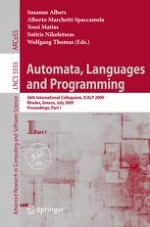2009 | Buch
Automata, Languages and Programming
36th International Colloquium, ICALP 2009, Rhodes, Greece, July 5-12, 2009, Proceedings, Part I
herausgegeben von: Susanne Albers, Alberto Marchetti-Spaccamela, Yossi Matias, Sotiris Nikoletseas, Wolfgang Thomas
Verlag: Springer Berlin Heidelberg
Buchreihe : Lecture Notes in Computer Science
